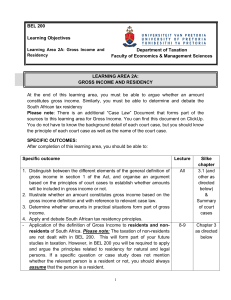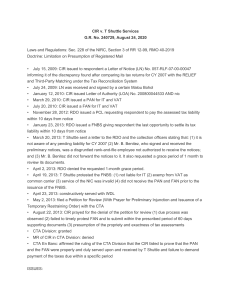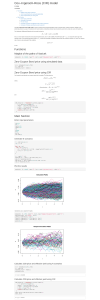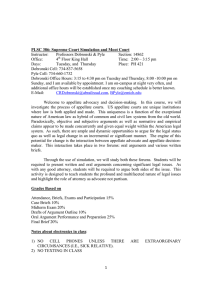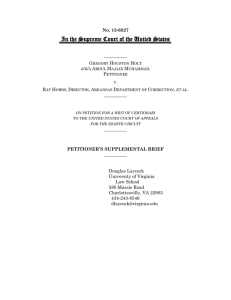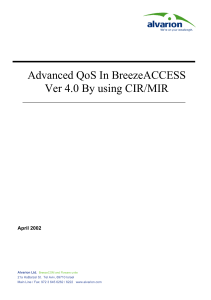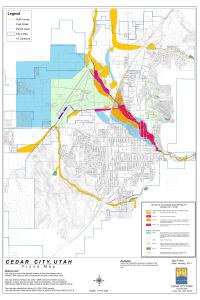Century-of-Information Strategy JCSR, JISC London www.nesc.ac.uk
advertisement
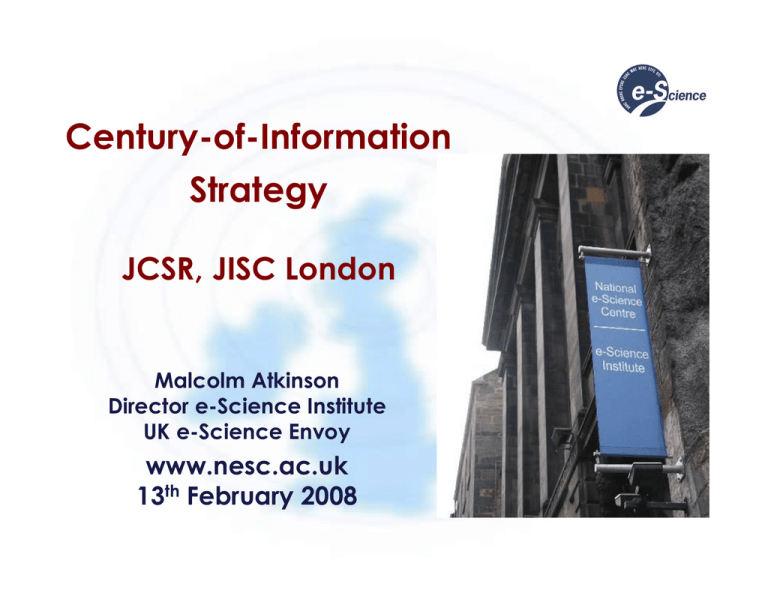
Century-of-Information Strategy JCSR, JISC London Malcolm Atkinson Director e-Science Institute UK e-Science Envoy www.nesc.ac.uk 13th February 2008 Outline • Why we need a CIR Strategy • What will it do • Why do it now Official UK Research Goals Table from Anna Kenway The 21st Century This is the century of information PM G. Brown, University of Westminster, 25 October 2007 • We can collect it • We can generate it • Can we move it? • We can store it • Can we use it? • Dramatic increase in data from sensors • Dramatic drop in cost of computation • Web-scale effects • Ubiquitous digital communications • Community intelligence • Global challenges • Transforming research, design, diagnosis, social behaviour, … The Information Explosion ユビキタス セキュリティ ではない 988EB = 1ZB (2010) 161EB (2006 by IDC) 情報系アンブレラ GRID/ペタコン ITS Slide: Satoshi Matsuoka Outline • Why we need a CIR Strategy •What will it do • Why do it now High-Level Goals for CIR • New world-leading research in all disciplines • New methods & new technology • High impact (transformative) • • • • • Sustained rapid transfer from invention to wide use Much wider engagement => More Research & Innovation Capacity & Skills building Innovative advances in Education Effective transfer between business & academia • Cost effective • Shared e-Infrastructure • Shared support for developing advances in ` Tools ` Services ` Trust • Skills mobility & interdisciplinary R&D facilitation Elements of CIR • Establish an Office of Strategic Coordination of Century-of-Information Research (OSCCIR) • Support the continuous innovation of research methods • Provide easily used, pervasive and sustained e-Infrastructure for all research • Enlarge the productive research community who exploit the new methods fluently • Generate capacity, propagate knowledge and develop a culture via new curricula OSCCIR Goals • Quinquenial planning cycle • Balance cost-effective eInfrastructure with enabling best research • Encourage development of skills in information & computationally intensive research • Ensure that achievement in interdisciplinary & information intensive research is well valued • Enable diversity, agility and creativity on increasingly powerful e-Infrastructure • Harmonise provision and increase interoperability • Monitor provision and ensure cost effective • Conduct strategic reviews to assess UK CIR in the global context • Improve quality and sustainability of services and tools • Improve pathways for exploitation • Promote public understanding of CIR • Consult on ethics Enable Rapid Innovation • Sustain support for interdisciplinary teams • Breakthroughs depend on talented research leaders • Plus strong supporting teams • Plus fundamental advances in all disciplines and technology • Provide an environment of composable components • Significant advances from familiar components • Composed in new ways • Provide powerful tools and services • With licence to experiment • Inject energy through challenges & long-term funds Enlarging the community • • • • • • • • • Multiple levels of attainment and curricula Shared training material Joint action with professional bodies Opportunities for developing skills Recognition of skills Communication about opportunities & benefits Work with industry Flagship examples & media outreach Messages through media, museums and schools Education for CIR • Research council Doctoral training accounts • HE FCs and RCs develop incentives • Organise flow from grant-funded research to education • Workshops on educational goals and the means of achieving them • Eventually deliver input into schools curricula Outline • Why we need a CIR Strategy • What will it do •Why do it now Changing Context for Research • Growing proportion is collaborative effort • International challenges, facilities & collaboration / competition • Digital-systems revolution • Automation, sensors, instruments, computers, data & networks • Pervasive use of digital devices and data • Data deluge • Shared remote experimental facilities • Real-time control and analysis • Ambient computational and content services • Community expectations, collaborations & intelligence • Public engagement in ethics, green energy, decisions & policy • In all professions information systems, data analysis and computational modelling will become prevalent Dangers from Inaction • Loss of competitive position • Less agile innovation • Fewer collaborating communities • Less interdisciplinary and community effects • Poor return on investment • Sharing lost, effort duplicated • Community fragmentation, aggregation harder • Loss of skill mobility • Lack of expansion of the active community • Loss of international influence & opportunities Questions Photographer: Kathy Humphry OSCCIR Stakeholders • • • • General public Researchers Educators Institutions • Universities, Research Centres • Commercial Information Systems R&D • Users • Business, government, education, healthcare & organisations • Funders • DIUS, research councils, funding councils, research-funding charities & TSB




